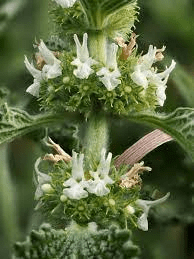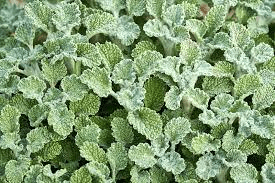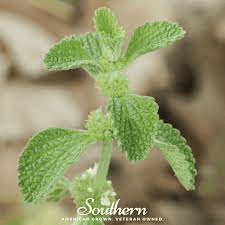White Horehound (Marrubium vulgare) is a perennial herb belonging to the Lamiaceae family, native to Europe, North Africa, and parts of Asia. This herbaceous plant has a long history of traditional use in herbal medicine and culinary practices.
In traditional herbal medicine, White Horehound has been valued for its diverse medicinal properties. The plant contains bioactive compounds, including marrubiin, which contribute to its potential health benefits.
It has historically been used as an expectorant to alleviate coughs, bronchitis, and respiratory congestion. The herb’s expectorant action is believed to help loosen and expel mucus from the airways.
White Horehound is also recognized for its potential to soothe digestive discomfort. Its bitter principles are thought to stimulate the production of digestive juices, aiding in digestion and relieving symptoms such as bloating and indigestion. The herb’s traditional use extends to supporting liver and gallbladder function.
Moreover, White Horehound has been used for its potential antispasmodic properties. It may help relax smooth muscles, making it historically relevant in addressing spasms associated with conditions like irritable bowel syndrome (IBS) or menstrual cramps.
Externally, White Horehound has been used in traditional remedies for minor skin irritations and wounds. Poultices or ointments made from the herb have been applied topically to soothe skin conditions and promote healing.
Additionally, White Horehound has a history of use in culinary practices. Its leaves have a bitter taste and have been used to flavor foods and beverages. The plant has been historically utilized in making herbal teas, candies, and liqueurs.
Despite its historical use, individuals should approach White Horehound with caution, especially pregnant or breastfeeding women and those with certain medical conditions. As with any herbal remedy, it’s advisable to consult with healthcare professionals before using White Horehound for medicinal purposes.
While White Horehound has a rich history in traditional medicine, more research is needed to understand its specific mechanisms of action, potential interactions, and optimal dosages for various health conditions.
The Botanical Description of White Horehound
1. Leaf Structure: White horehound boasts deeply lobed, wrinkled, and woolly leaves that are gray-green in color, providing a unique visual characteristic.
2. Flower Appearance: The flowers of white horehound form dense clusters at the tips of the stems, showcasing small, two-lipped, white or pale pink blooms.
3. Stem Characteristics: The plant has square stems covered in fine hairs, and it grows erect, reaching a height of about 1 to 2 feet.
4. Habitat Preference: White horehound thrives in well-drained, nutrient-poor soils, often found in open fields, roadsides, and waste areas, showcasing its adaptability.
5. Aromatic Qualities: Crushing the leaves releases a distinct, strong, and somewhat minty aroma, contributing to its recognition.
6. Root System: White horehound develops a branched root system that anchors the plant in the soil and aids in nutrient absorption.
7. Flowering Season: The flowering period typically occurs in late spring to early summer, with blooms attracting pollinators like bees.
8. Foliage Texture: The leaves are covered in fine hairs, giving them a woolly texture that helps the plant conserve water in arid conditions.
9. Reproductive Strategy: White horehound reproduces primarily by seeds, ensuring its continued presence in various ecosystems.
10. Overall Appearance: With its distinctively lobed leaves, square stems, and clusters of white or pale pink flowers, white horehound stands out in natural landscapes.
The Geographic Distribution of White Horehound

1. Europe: Native to Europe, white horehound is widespread in countries with temperate climates, including the Mediterranean region.
2. North America: Introduced to North America, white horehound has naturalized in regions with suitable conditions, such as the United States and Canada.
3. Asia: White horehound has been introduced and cultivated in various parts of Asia, including the Middle East and Central Asia.
4. Africa: In Africa, white horehound can be found in certain regions, thriving in both arid and more humid environments.
5. Australia: Introduced to Australia, white horehound has become naturalized in specific areas, showcasing its adaptability.
6. South America: Some regions of South America also support white horehound populations, particularly in temperate climates.
7. Urban Environments: White horehound has adapted to urban environments, often colonizing disturbed areas, roadsides, and fields.
8. Temperate Climates: The plant is well-suited to temperate climates, where it can withstand variations in temperature and soil conditions.
9. Disturbed Habitats: White horehound thrives in disturbed habitats, making it a common sight in areas with human activities.
The Chemical Composition of White Horehound
1. Marrubiin: The most prominent compound in white horehound, marrubiin, is responsible for its bitter taste and potential therapeutic effects.
2. Flavonoids: White horehound contains various flavonoids, contributing to its antioxidant properties and potential health benefits.
3. Tannins: Tannins in white horehound provide astringent qualities, influencing its traditional use for respiratory and digestive issues.
4. Essential Oils: White horehound produces essential oils with compounds like terpenes, contributing to its aromatic properties.
5. Diterpenes: Certain diterpenes found in white horehound may have pharmacological significance, influencing its medicinal potential.
6. Volatile Compounds: White horehound’s aroma is attributed to volatile compounds, adding to its sensory characteristics.
7. Polyphenols: White horehound contains polyphenolic compounds that contribute to its antioxidant and anti-inflammatory effects.
8. Alkaloids: Although present in smaller amounts, alkaloids in white horehound may play a role in its overall chemical profile.
9. Saponins: White horehound contains saponins, which may have expectorant properties and contribute to its traditional use for respiratory health.
10. Trace Elements: The plant absorbs trace elements from the soil, further diversifying its chemical composition.
11. Bitter Substances: White horehound’s bitterness is attributed to various bitter substances, influencing its taste and potential therapeutic actions.
12. Mucilage: White horehound contains mucilage, contributing to its soothing effects on mucous membranes and respiratory tissues.
Read More: 20 Medicinal Health Benefits Of Borage (Borago officinalis)
The Medicinal Health Benefits Of White Horehound (Marrubium vulgare)

1. Respiratory Health: White horehound has traditionally been used to support respiratory health, providing relief for conditions like coughs, colds, and bronchitis.
2. Expectorant Properties: The presence of saponins in white horehound contributes to its expectorant properties, facilitating the clearance of mucus from the respiratory tract.
3. Digestive Aid: Tannins and bitter substances in white horehound may support digestion by promoting the production of digestive juices and improving appetite.
4. Anti-Inflammatory Effects: White horehound’s polyphenolic compounds contribute to its anti-inflammatory effects, potentially beneficial for inflammatory conditions.
5. Antioxidant Support: Flavonoids, polyphenols, and essential oils in white horehound provide antioxidant support, helping neutralize free radicals in the body.
6. Immune System Modulation: White horehound may modulate the immune system, supporting overall immune function.
7. Antispasmodic Effects: The plant has been traditionally used for its antispasmodic properties, potentially relieving spasms in the gastrointestinal tract.
8. Menstrual Support: White horehound’s potential as a uterine stimulant has led to its traditional use for menstrual issues, although caution is advised.
9. Anti-diabetic Effects: Some studies suggest that white horehound may have hypoglycemic effects, potentially benefiting individuals with diabetes.
10. Liver Support: Compounds in white horehound may offer liver-protective effects, contributing to overall liver health.
11. Cardiovascular Health: White horehound may have a positive impact on cardiovascular health, with potential benefits for blood pressure and circulation.
12. Anti-allergic Effects: Certain compounds in white horehound may exhibit anti-allergic effects, making it potentially beneficial for allergy relief.
13. Skin Conditions: White horehound’s anti-inflammatory and soothing properties may be applied topically for skin conditions like eczema and dermatitis.
14. Weight Management: The bitter components in white horehound may support weight management by promoting digestion and reducing cravings.
15. Anxiety and Stress: White horehound’s calming properties may contribute to stress reduction and anxiety relief.
16. Antimicrobial Action: The plant’s constituents may exhibit antimicrobial effects, potentially aiding in the fight against certain infections.
17. Joint Health: White horehound’s anti-inflammatory properties may contribute to joint health, providing relief for conditions like arthritis.
The Methods of Usage to Achieve the Provided Health Benefits Of White Horehound (Marrubium vulgare)
1. Herbal Tea: White horehound tea is a popular and traditional method of consumption. Steep dried or fresh leaves in hot water for a soothing beverage.
2. Tinctures: Tinctures offer a concentrated form of white horehound’s beneficial compounds. Follow recommended dosage instructions for precise use.
3. Syrups: White horehound syrup can be prepared, providing a sweet and palatable way to consume the herb, especially for respiratory or digestive benefits.
4. Steam Inhalation: Inhaling steam infused with white horehound can be beneficial for respiratory health, helping to alleviate congestion and promote clearer breathing.
5. Herbal Infusions: Infusing white horehound in oil or water allows for versatile usage. Herbal infusions can be applied topically or added to various formulations.
6. Capsules or Tablets: White horehound supplements in capsule or tablet form offer a convenient option for those looking to incorporate its health benefits into their routine.
7. Topical Balms: Applying a balm or salve containing white horehound can target specific skin conditions or provide soothing effects.
8. Culinary Use: Utilizing white horehound in culinary applications, such as adding leaves to salads or soups, introduces its benefits into the diet.
9. Poultices: Creating a poultice from crushed white horehound leaves may offer localized relief for skin conditions, wounds, or insect bites.
10. Smoking Blends: While not common, white horehound has been historically included in herbal smoking blends for respiratory benefits.
The Side Effects Of Using White Horehound Medicinal Plant
1. Allergic Reactions: Individuals with known allergies to plants in the Lamiaceae family (mint family) may experience allergic reactions to white horehound.
2. Gastrointestinal Upset: Excessive consumption of white horehound may lead to mild gastrointestinal upset in some individuals.
3. Pregnancy and Breastfeeding: Pregnant or breastfeeding individuals should consult healthcare professionals before using white horehound due to limited safety data.
4. Blood Sugar Levels: Individuals with diabetes should monitor their blood sugar levels when using white horehound, as it may influence glucose metabolism.
5. Blood Clotting: White horehound’s potential antiplatelet effects may impact blood clotting, so caution is advised for individuals with bleeding disorders.
6. Sedation: White horehound’s calming properties may cause drowsiness, so it’s advisable to avoid activities requiring alertness after use.
7. Plant Parts Used: Different plant parts may have varying concentrations of compounds; therefore, it’s crucial to use white horehound as directed.
8. Respiratory Depression: Excessive use may contribute to respiratory depression, particularly when combined with other depressants.
9. Kidney Health: Individuals with kidney conditions should use white horehound cautiously, as excessive diuretic effects may impact renal function.
10. Skin Sensitivity: Direct skin contact with white horehound may cause sensitivity or irritation in some individuals.
11. Quality of Products: Choosing high-quality white horehound products from reputable sources ensures purity and minimizes the risk of contaminants.
12. Duration of Use: Prolonged use of white horehound should be monitored, and breaks in usage may be advisable to prevent tolerance or dependency.
Read More: Different Varieties of African Eggplant and their Characteristics
The Scientific Research and Studies of White Horehound

1. Anti-Inflammatory Effects: Studies indicate that white horehound possesses anti-inflammatory properties, attributed to compounds like marrubiin.
2. Respiratory Benefits: Research supports the traditional use of white horehound for respiratory conditions, suggesting potential benefits for coughs and bronchitis.
3. Antioxidant Capacity: White horehound’s flavonoids and polyphenols contribute to its antioxidant capacity, aiding in the neutralization of free radicals.
4. Gastrointestinal Support: Some studies suggest that white horehound may offer gastrointestinal support, with potential benefits for digestion.
5. Antimicrobial Activity: White horehound exhibits antimicrobial properties in certain studies, indicating its potential in combating microbial infections.
6. Wound Healing: Research indicates that white horehound may have wound-healing properties, attributed to its anti-inflammatory and astringent effects.
7. Liver Protective Effects: Certain compounds in white horehound may have hepatoprotective effects, supporting liver health.
8. Anti-diabetic Potential: Preliminary studies suggest that white horehound may have anti-diabetic effects, influencing glucose metabolism.
9. Cardiovascular Impact: White horehound may have cardiovascular benefits, including potential effects on blood pressure and circulation.
10. Immunomodulatory Properties: Some compounds in white horehound may modulate the immune system, contributing to overall immune support.
The Safety Precautions and Recommendations In Using White Horehound (Marrubium vulgare)
1. Dosage Guidelines: Adhere to recommended dosage guidelines to avoid potential side effects or toxicity.
2. Consultation with Healthcare Professionals: Individuals with pre-existing medical conditions or those taking medications should consult healthcare professionals before using white horehound.
3. Pregnancy and Breastfeeding: Pregnant or breastfeeding individuals should seek medical advice before incorporating white horehound into their health regimen.
4. Monitoring Blood Sugar Levels: Individuals with diabetes should monitor their blood sugar levels when using white horehound, as it may influence glucose metabolism.
5. Blood Clotting Disorders: Caution is advised for individuals with bleeding disorders, as white horehound’s mild antiplatelet effects may impact blood clotting.
6. Sedation and Driving: White horehound’s soothing properties may cause drowsiness, so it’s advisable to avoid activities requiring alertness after use.
7. Allergic Sensitivity: Individuals with known plant allergies should exercise caution and perform a patch test before using white horehound.
8. Kidney Conditions: Individuals with kidney conditions should use white horehound cautiously due to its diuretic effects.
9. Skin Sensitivity: Direct skin contact with white horehound may cause sensitivity or irritation in some individuals.
10. Quality of Products: Choose high quality white horehound products from reputable sources to ensure purity and minimize the risk of contaminants.
11. Duration of Use: Prolonged use of white horehound should be monitored, and breaks in usage may be advisable to prevent tolerance or dependency.
12. Interaction with Medications: White horehound may interact with certain medications, such as anticoagulants or sedatives. Consultation with healthcare providers is essential for those on medication.
FAQs About White Horehound (Marrubium vulgare) Medicinal Plant
1. Is white horehound safe for daily consumption?
White horehound is generally considered safe when used as directed. However, moderation is key, and daily use should align with recommended dosage guidelines.
2. Can white horehound be used for children?
While white horehound has been historically used for various purposes, including respiratory support in children, it’s crucial to consult healthcare professionals for appropriate dosages and safety considerations.
3. Are there any contraindications for using white horehound?
Individuals with allergies to the Lamiaceae family, bleeding disorders, kidney conditions, or those on specific medications should exercise caution and seek medical advice before using white horehound.
4. How long does it take to experience the benefits of white horehound?
The timeframe for experiencing benefits may vary based on individual factors and the specific health concern. Continuous and consistent use may be necessary for some benefits.
5. Can white horehound be used for skin conditions?
White horehound’s anti-inflammatory and soothing properties make it a consideration for skin conditions. However, a patch test is recommended, and consultation with healthcare professionals is advised.
6. Is white horehound addictive?
White horehound is not known to be addictive. However, prolonged use without breaks may lead to tolerance. It’s advisable to use it judiciously and take breaks as needed.
7. Can white horehound be used during pregnancy and breastfeeding?
Pregnant and breastfeeding individuals should consult with healthcare professionals before using white horehound due to limited safety data for these populations.
8. What is the recommended dosage of white horehound?
Dosage recommendations can vary based on factors such as age, health status, and the form of white horehound used. Following product instructions or consulting with healthcare professionals is advisable.
9. Does white horehound have interactions with medications?
White horehound may interact with medications affecting blood clotting, blood sugar levels, or those with sedative effects. Consultation with healthcare providers is essential for individuals on medication.
10. Can white horehound be used for anxiety?
While white horehound’s calming properties may contribute to stress reduction, it’s not specifically associated with treating anxiety. Individuals with anxiety concerns should seek advice from healthcare professionals.
11. Can white horehound be grown at home?
Yes, white horehound can be grown at home in well-drained soil and sunny locations. It’s a hardy plant that adapts well to different climates.
12. What is the best time to harvest white horehound?
The best time to harvest white horehound is during its flowering period in late spring to early summer. Harvest leaves and stems for medicinal use.
13. Can white horehound be used for pets?
The use of white horehound for pets should be approached with caution. Consultation with veterinarians is recommended to ensure safety and appropriate dosages.
14. Are there any white horehound alternatives?
While white horehound has unique properties, other herbs like thyme, oregano, or elecampane may offer similar respiratory or digestive benefits.
15. Can white horehound be used as a preventive measure for respiratory conditions?
White horehound’s traditional use for respiratory health may make it a consideration for preventive measures. However, individual health conditions should be taken into account.

